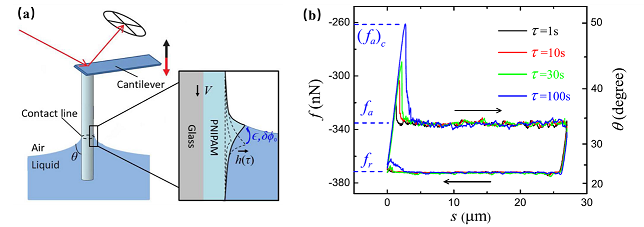- Home >> News >> Research Progress
Research Progress
Research Progress in State and Rate Dependent Wetting Dynamics on a Soft Surface
Date:2020-09-28Source:
Pinning-depinning (or stick-slip) is a common phenomenon both in nature and in many engineering applications. It is often observed in non-equilibrium disordered systems as a yield response to a smoothly-varying external forcing. Examples include the Barkhausen noise in soft magnetic materials, the motion of vortices in superconductors, the seismic activity in earthquakes, the acoustic emission in mesoscopic crystal plasticity, and fracture propagation. The pinning-depinning transition often exhibit a state-dependent increase of pinning strength owing to the contact aging. However, despite the large number of experimental and theoretical investigations, the microscopic mechanism responsible for this time- and speed-dependent behavior is not well understood because of its complexity and the lack of direct measurement of the pinning-depinning events.
The researcher Dr. Guan, from Institute of Mechanics, Chinese Academy of Sciences, designed a well-characterized model system, namely a moving contact line between a liquid-air interface and a soft solid surface, to study the pinning-depinning dynamics using a “long needle” atomic force microscope (Fig. a). The measured capillary force hysteresis shows a distinct overshoot for the depinning of a static contact line (Fig. b), and the overshoot amplitude grows logarithmically with both the hold time and fiber speed. To the best of our knowledge, this is the first time that the time (or state) and speed (or rate) dependent pinning-depinning transition is observed for a contact line on an aging soft surface. A unified model based on the slow growth of a wetting ridge and force-assisted barrier crossing is developed to explain the dynamic behaviors. The experimental findings have important implications to a common class of problems involving depinning dynamics in a defect or roughness landscape, such as friction of solid interfaces.
This work was recently published in Physical Review Letters (Guan et al. Phys. Rev. Lett. 124, 188003 (2020)). This work was supported by Chinese Academy of Sciences and National Natural Science Foundation of China.
